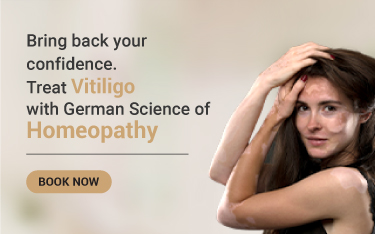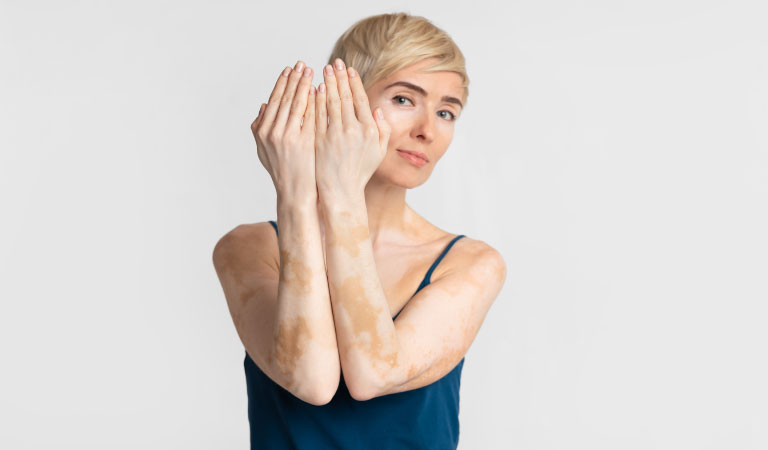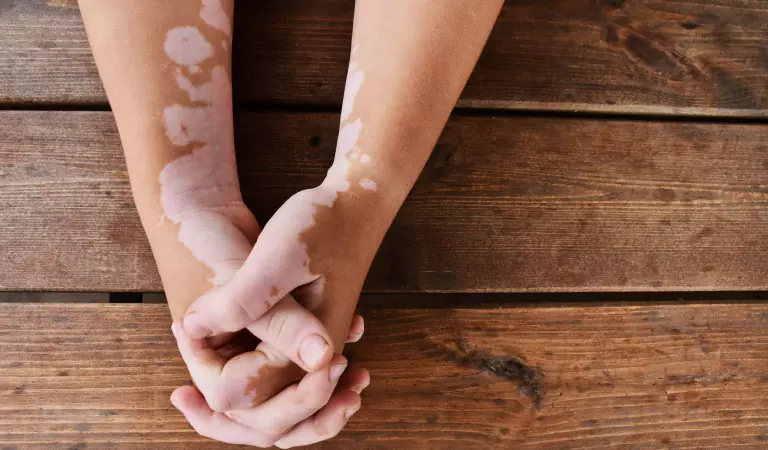Vitiligo Treatment in Dubai, UAE
Vitiligo is a skin condition characterised by the loss of pigment in certain areas. For those seeking Vitiligo Treatment in Dubai and Abu Dhabi, specialised treatments are available to manage and improve the appearance of depigmented patches effectively.
When should you see a doctor for Vitiligo treatment?
If you notice any areas of your skin, hair, or mucous membranes losing colour, you should see a doctor for vitiligo treatment.
Early consultation is crucial because, while vitiligo has no cure under general medicine, there are treatments available that can help slow down or stop its progression. These treatments include corticosteroid creams, light therapy, and immune system medications, which can help restore some of the lost skin color.
However, the effectiveness of vitiligo treatments varies from person to person, and results may not be permanent. Regular follow-ups with a healthcare provider are often necessary to manage the condition and prevent relapse.
Seeking professional medical care early can also help rule out other potential causes of skin discolouration and provide you with the best possible management plan tailored to your specific needs.
Homeopathy treatment for Vitiligo
Homeopathy offers a potential solution for vitiligo, a condition challenging to treat conventionally. It works on slowing down or stopping color loss and potentially restoring skin pigmentation. Vitiligo often involves the immune system attacking and damaging melanocytes, resulting in their failure.
At Dr Batra's, specialists customize homeopathic treatments for vitiligo based on individual diagnoses. Their approach encompasses specialized vitiligo treatment, incorporating psychotherapy, specific homeopathic remedies for vitiligo, and personalized dietary advice. Homeopathic treatment for vitiligo aims to rebalance the body's immune system gently. This approach not only helps in delaying the condition's progression—an important concern for those affected by vitiligo—but also strives to bring back normal skin pigmentation.
How Effective Are Homeopathic Medicines For Vitiligo
Homeopathy offers promising results in managing Vitiligo. Its individualized approach targets underlying imbalances, aiming to stimulate the body's natural healing abilities. Studies show positive outcomes in halting the spread and inducing repigmentation of Vitiligo patches with homeopathic medicines, offering hope for those seeking holistic treatment options.
Reviews of Our Vitiligo Treatments in Dubai
Here are just a few of the reviews from patients who have successfully undergone Vitiligo treatment at Dr Batra's®:
Why Choose Dr Batra's® For Vitiligo Treatment in Dubai & Abu Dhabi
Dr Batra's® Healthcare is well-known and people trust it for its all-natural homeopathy vitiligo treatment. We have successfully treated over a million patients globally in the last 35 years. Our homeopathy dermatologist thoroughly assesses your condition, family, and medical history before prescribing individualized Homeopathy treatment.
Our highly qualified and experienced doctors ensure a 30- to 40-minutes in-depth consultation with the patient during which they analyze the patient's physical, mental, and psychological concerns and correctly diagnose the ailment using the medical science of homeopathy.
For the best vitiligo treatment in Dubai, and Abu Dhabi book an appointment with our best skin specialist now
What is Vitiligo?
Vitiligo is a condition that causes the skin to lose its color, leading to white patches that can affect people of any race. It is often more noticeable on individuals with darker skin due to the stark contrast between the natural skin tone and the white spots caused by vitiligo. In most cases, the affected skin begins to pale and progressively turns white. These discolored areas tend to grow over time.
Vitiligo is believed to be an autoimmune condition, where the body's immune system mistakenly attacks pigment cells. While the exact cause remains unknown, vitiligo can develop at any age, though it most commonly appears before age 30. Although there is no definitive cure, treatments like UV light therapy, topical medications, and consistent homeopathy treatment for vitiligo can help manage the condition and, in some cases, restore skin color.
Vitiligo Solutions
There are multiple solutions available in the market for vitiligo treatment, along with potential side effects:
Topical corticosteroids: These creams or ointments can help repigment the skin. However, prolonged use may lead to skin thinning, stretch marks, and discoloration.
Phototherapy (UVB therapy): This treatment involves exposing the skin to UVB light. Side effects may include redness, itching, and increased risk of skin cancer with long-term use.
Topical calcineurin inhibitors: These medications can help restore skin color, but they might cause burning, itching, and an increased risk of skin infections.
Depigmentation: In cases of widespread vitiligo, some individuals opt to depigment their remaining skin to match the affected areas. This process can lead to permanent skin sensitivity and increased susceptibility to sunburn.
Surgical procedures: Techniques like skin grafting or melanocyte transplantation may have potential risks such as scarring, infection, and lack of consistent results.
It's important to consult a healthcare professional before starting any vitiligo treatment, as they can provide personalized advice considering individual health conditions and potential side effects.
Where does Vitiligo show up on the body
Vitiligo can appear anywhere on the body. Usually, vitiligo first appears in patches in areas like:
- Face
- Arms
- Hands
- Feet
- Back
As the spots and patches expand, vitiligo may spread to other parts of a person's body. There can also be a color loss that occurs in certain people's mucous membranes, which include the genitalia, inside the mouth, and even the nose. Vitiligo also results in white or prematurely grey hair on the scalp. Some individuals experience color loss and get glowing spots on the colored area of their eyes as well.
In rare cases, vitiligo can even affect the whole body. This is referred to as universal or total vitiligo.
Vitiligo is believed to be associated with different autoimmune and inflammatory diseases such as
- Diabetes Mellitus
- Addison's Disease
- Alopecia Areata
- Hypothyroidism
- Hyperthyroidism
- Psoriasis
- Pernicious Anemia
Types of Vitiligo
There are two major types of vitiligo non-segmental vitiligo and segmental vitiligo
- Non-Segmental Vitiligo: Spreads slower than segmental vitiligo and it affects the mouth, knees, feet, arms, hands & back.
- Segmental Vitiligo: Spreads faster but is more stable than non-segmental vitiligo. It usually affects areas of the skin close to nerves.
Causes of Vitiligo
- Autoimmune condition
- Genetic changes
- Stress
- Environmental triggers
An autoimmune condition where the immune system attacks melanocytes, causing depigmentation.
- Genetic changes or predispositions that may increase the likelihood of developing vitiligo.
- Stress, which can exacerbate or trigger the onset of vitiligo due to its impact on the immune system.
- Environmental triggers like sunburn, chemicals, or traumatic events may contribute to vitiligo development.
Symptoms of Vitiligo
The most noticeable sign of vitiligo is the emergence of white spots on the skin. These are usually substantially lighter than the patient's ordinary skin, and they are especially evident in those with a darker complexion.
Vitiligo symptoms include the following and can develop at any stage of life:
- Patchy loss of skin color
- Premature whitening or greying of hair on your scalp, eyelashes, eyebrows, or beard.
- Loss of color in the tissues that line the inside of your mouth and nose.
- Loss of or change in color of the inner layer of the eyeball is also one of the symptoms of vitiligo
Thyroid dysfunction is one of the most commonly observed disorders in vitiligo patients, and having a thyroid condition may be a warning sign that vitiligo may develop.
What other conditions look like Vitiligo?
Chemical Leukoderma:
Description: Occurs due to exposure to certain chemicals.
Appearance: Irregular white patches on the skin where the chemical contact occurred.
Distinguishing Factor: Limited to areas exposed to chemicals, unlike Vitiligo which isn't localized to specific contact areas.
Tinea Versicolor:
Description: Fungal skin infection causing discoloration.
Appearance: Small, scaly patches of skin, usually lighter or darker than surrounding skin.
Distinguishing Factor: Patches tend to be lighter or darker but not typically stark white as in Vitiligo.
Albinism:
Description: Genetic condition affecting melanin production.
Appearance: The entire body or parts lack pigmentation, leading to very pale skin, hair, and often light eyes.
Distinguishing Factor: Albinism affects overall pigmentation, while Vitiligo forms distinct, irregular patches.
Pityriasis Alba:
Description: Mild skin condition primarily affecting children.
Appearance: Light-colored, slightly scaly patches on the face.
Distinguishing Factor: Unlike Vitiligo's stark depigmentation, Pityriasis Alba typically presents with mild, faded patches that may improve with moisturizers.
Remember, while these conditions may share some visual similarities with Vitiligo, they have distinct characteristics in terms of causation, distribution, and appearance. It's crucial to consult a dermatologist for an accurate diagnosis and appropriate treatment plan.
Emotional and social impact of Vitiligo
According to an NCBI study on the relationship between vitiligo and self-esteem, the majority of patients with vitiligo have low confidence and self-esteem. According to the study, 70% of women and 54% of men who took part had self-esteem concerns as a result of their vitiligo. Those with darker skin have been proven to struggle more with vitiligo, as pigment loss (depigmentation) is more noticeable on darker skin.
Living with vitiligo presents emotional challenges, impacting mental health deeply. Society's beauty norms often trigger embarrassment and shattered self-esteem due to stares and remarks. Despite this, finding empowerment in one's unique appearance through support groups and online communities offers solace. Protecting sensitive areas from the sun becomes crucial, while treatment options like creams and phototherapy aid repigmentation. However, the most crucial journey is self-acceptance—embracing oneself entirely despite societal pressures. By advocating for awareness and acceptance, those with vitiligo defy stereotypes, inspiring others to embrace differences proudly. This resilience fosters confidence, contributing to a more inclusive society that celebrates individuality over conformity.
FAQs
Can chemicals cause vitiligo?
Is vitiligo contagious?
Are there any natural remedies for vitiligo?
Can vitiligo come back after successful treatment?
Can homeopathy cure vitiligo or provide symptom relief?
How long does it take for homeopathy medicines to cure vitiligo?
Will my natural skin color return with vitiligo?
Key Points







